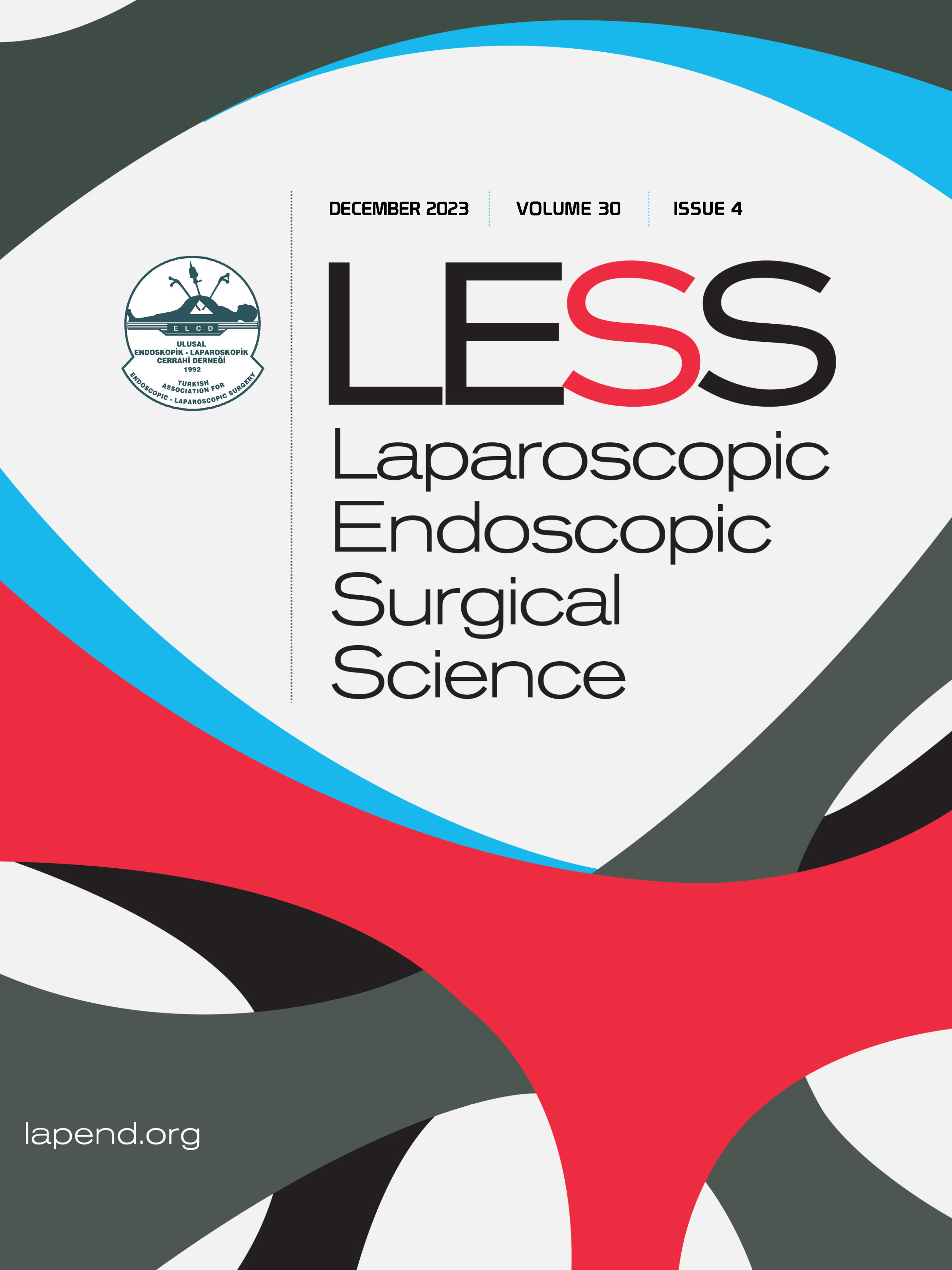Volume: 7 Issue: 4 - 2000
| 1. | Laparoscopic Hernia Repair: Is It Helpfull For Patients Earlier Return To Work Güner Öğünç, Cumhur Arıcı, Mustafa Akaydın Page 0 Abstract | |
| CASE REPORT | |
| 2. | Video-assisted thoracoscopic excision of bronchogenic cyct: A case report Okan Solak, Muzaffer Metin, Songül Çuhadaroğlu, Mehmet Kullep, Atilla Gürses Pages 125 - 127 The cystic leşions of mediastinum and lung parenchyma are mostly acquired, and a small number is congenital. The bronchogenic cyst which is one of the congenital lung cysts, is frequently seen in children and adolescents. Bronchogenic cysts are 10-15% of primary mediastinal masses and mostly asymptomatic.ln âdequate lesions with mediastinal cystic leşions, cyst excision by VATS should be preferred instead of thorocotomy if complete resection can be done. We wanted to discuss the effectivity Of VATS İn a case in which we excissed. |
| 3. | Evaluation Of Contralateral Patent Processus Vaginalis By Diagnostic Laparoscopy In Unilateral Hernia B. Haluk Güvenç, Melih Tugay Pages 128 - 132 It is stated that in 40 60 % of children with a unilateral inguinal hernia, a contralateral patent processus vaginalis (CPPV) is present during routine bilateral exploration. Other series report a 10 40 % return for a contralateral hernia repair when unexplored. Introduction of fine laparoscopic instruments suitable for infants and children has popularized the technique among pediatric surgeons. Our aim is to evaluate the presence of CPPV in children with a unilateral inguinal hernia by means Of diagnostic laparoscopy. In a prospective study we evaluated and treated 36 consecutive cases for a known inguinal hernia. Four patients with bilateral hernias and an additional four with complicated clinical situations or due to technical difficulties did not undergo laparoscopic evaluation. Following preparation of the ipsilateral hernia sac and cannulation, the abdomen was insufflated up to 10 mmHg. Contralateral inguinal region was manually examined for a suspect PPV. A diagnostic laparoscopy was performed via hernia sac using a 45-degree, 5-mm telescope. We found a CPPV in eight (29%) of the 28 cases. Children under one year Of age showed a 40% incidence, where those over One year showed a 22% incidence of CPPV. 25% of the cases with a right inguinal hernia and 33% of the cases with a left inguinal hernia had a CPPV. We found that insufflation is unreliable in determining the presence Of CPPV manually. We believe that diagnostic laparoscopy is an easy and cost effective procedure in determining the presence Of a CPPV. It decreases both the risk and cost Of a second operation and avoids injury of the cord in an unnecessary exploration. |
| 4. | Is it rational to do a laparoscopic intervention to probably malignant adnexal masses? a case report and a literature review Süleyman E. Akhan, Bülent Ergun Pages 133 - 137 Laparoscopic surgery is a safe method in the diagnosİs and treatment Of benign adnexal masses. The better postoperative tolerance and the, shorter hospital stay gradually make the laparoscopic surgery the preferred method in the treatment of adnexal masses. Although the malignant tumors also may be managed laparoscopically, still the classical approach is to apply this kind of surgery for the treatment of benign ovarian lesions. This condition makes the preoperative evaluation of the patient extremely important.ln this article we presented a case with high CA 125 plasma levels and an adnexal mass with heterogenous echos on transvaginal ultrasound and tried to discuss the approach and the algorythm of management of this kind of patients. |
| RESEARCH ARTICLE | |
| 5. | Surveillance in patients in whom galbladder cancer was diagnosed after laparoscopic cholecystectomy Tayfun Karahasanoğlu, Ayhan Özsoy, Sibel Erdamar, Arif Sami Kahya, Ismail Hamzaoğlu, Nihat Yavuz, Yavuz Eryavuz, Ahmet Nejat Özbal Pages 138 - 142 INTRODUCTION: To research the survey and metastasis in port site in patients in whom gallbladder cancer was diagnosed after laparoscopic cholecystectomy. METHODS: Of the 4391 laparoscopic choleccystectomy patients (0,18%) gallbladder cancer was diagnosed by the post operative histopathological investigation,were analysed on behalf of metastases in port site and survey. RESULTS: In eight laparoscopic cholecystectomy patients (O,18 %) gallbladder cancer was diagnosed which was not being known before or during the operation. In four Of the seven followed patients pathological grade was pT2 and in three was pT3. In one patient (14,7 To) port site metastasis was developed two months after laparoscopic cholecystectomy. Mean surveillance time was 30 months. DISCUSSION AND CONCLUSION: The tendecy for the treatment of patients whose gallbladder cancer was diagnosed after laparoscopic cholecystectomy depends on the choice of the surgeon. More reports are needed for this problem to be solved. |
| 6. | Our Laparoscopic Repair Experience In Ventral Hernias Ediz Altınlı, Cihan Uras, Selin Kapan, Tarık Akçal, Ümit Balcısoy Pages 143 - 146 INTRODUCTION: Evaluation Of techniqual properties and outcomes of laparoscopic ventral hernia repair. METHODS: Laparoscopic repair Was applied to 22 ventral hernia cases in Istanbul University, Cerrahpa¥a Medie-al Faculty, Department Of General Surgery, section of Gürkan C between January 1998-January 2000. RESULTS: : Total number of cases Were 22. There were I I umblical hernia cases with three recurrences, 10 incisiOnal hernias and one epigastric hernia. Six of the incisional hernia cases were originated from Phannenstiel incision, one from distal part of the upper midline incision, one from proximal part of lower midline incision and two of the cases originated from right transrectal incisions. Nineteen Of the cases were female and three Of them were male. The youngest case Was 37 years Old and the oldest was 70 years old with the mean age of the series as 53.95±2.03 years. In two of the cases polytetrafloroetylene mesh of the appropriate size was used for repair of the hernia and polipropilene mesh was used in the remaining cases. Six of the cases were discharged from the hospital in the first postoperative day and the others were discharged in the second postoperative day. In a case of recurrent umblical hernia, seroma around the umblicus was detected in the early postoperative period. Cases were followed up between 6-12 month with a mean of 9.14 ± 0.54 months by regular follow-ups at 1st, 3rd, 6th and 12th months. No recurrence was observed during the follow up period. DISCUSSION AND CONCLUSION: Laparoscopic ventral hernia repair with mesh application is a preferable and safe tecnique in selected cases with advantages of 0% mortality rate, 4.54% morbidity rate (1 / 22), shorter hospital stay, satisfactory cosmetic results and rapid return to daily activities. |
| 7. | Laparoscopic Appreach To The Pyloric Stenosis Due To Peptic Ulcus Gökhan Adaş, Hasan Ofluoğlu, Üzeyir Tuncer, Özgür Odabaş, Sefa Tüzün, Tamer Karşıdağ Pages 147 - 152 INTRODUCTION: METHODS: RESULTS: DISCUSSION AND CONCLUSION: |
| 8. | Laparoscopic Treatment For Left Inguinal Hernia And Left Intraabdominal Testis Ömer Engin, A. Serdar Göker, Osman Tan Fırat, Nazmi Mutlu Pages 153 - 156 Abstract | |
| 9. | Anethesia In Laparoscopic Cholecystectomy Demet Koç, Rasim Gençosmanoğlu, Orhan Şad Pages 162 - 166 Abstract | |















